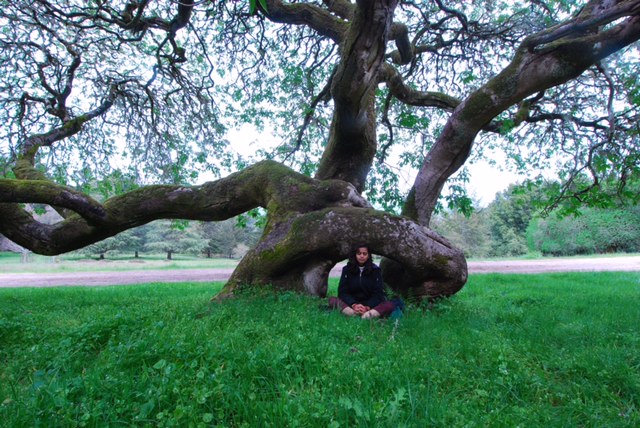By Thich Nhat Hanh and Katherine Weare

TEACHING NOTES
Why practice like a tree in a storm?
• To get in touch with the breath in the belly in the present moment.
• To calm and relax body and mind.
• To increase a sense of stability and safety.
This variation uses the image of a tree in a storm to help you and your students experience the sense of having a strong and stable “trunk” on which you can rely while emotions rage in your “branches.” It may be best to practice it after you and your students have become used to belly breathing and getting in touch with the emotions.
By Thich Nhat Hanh and Katherine Weare

TEACHING NOTES
Why practice like a tree in a storm?
• To get in touch with the breath in the belly in the present moment.
• To calm and relax body and mind.
• To increase a sense of stability and safety.
This variation uses the image of a tree in a storm to help you and your students experience the sense of having a strong and stable “trunk” on which you can rely while emotions rage in your “branches.” It may be best to practice it after you and your students have become used to belly breathing and getting in touch with the emotions. It can also be used as a basic practice instead of the one above, especially for younger children.
It is best practiced first when things seem calm—with you and your class. It may be helpful to have a short discussion first with your class about what difficult emotions they have and what those emotions feel like. Be ready to hold the space for strong emotions as they then may arise. It can be helpful to focus on just one emotion, like anger. This way there is a specific felt experience to draw on in the practice. Once the students are used to the process, it will be easier to help them practice when strong emotions have arisen.
CORE PRACTICE
Materials and Preparation
• You need to be experienced in the practice yourself before you teach it to others.
• Mats or chairs depending on how you want people to sit or lie down.
• Bell and inviter (optional but recommended).
1. Bell
Invite one sound of the bell to signal the beginning of the practice.
2. Notice Your Breathing
Become aware of the in- and out-breath. No need to change the breath; just be aware of it.
3. Belly Breathing
Start with belly breathing—see above—and cover all stages up to and including “using the breath to calm mind and body.”
4. Aware of Painful Feelings
Become aware of any difficult or painful feelings in your mind or body.
If you have none right now, that is fine. By learning this practice when you are calm, you will be better prepared next time a strong emotion comes.
5. The Tree
Imagine now that you are a tree.
Your belly is like the trunk of the tree.
The strong feeling—anger or hurt or sadness—is like a storm making the high branches of your tree sway backward and forward in the wind.
Now come back down to the trunk of the tree, to your belly.
It feels stable and safe down at the trunk of your tree.
There is no need to think about what happened just now.
Just be aware of your breathing, your belly rising and falling.
Breathing in, I calm this strong feeling,
Breathing out, I can even smile to this strong feeling.
Stay breathing in and out.
We stay with the trunk of our tree.
There is still a storm going on. There is still emotion in us.
But we are breathing, in and out, deep and slow, belly rising, belly falling.
Down at the trunk of our tree we can breathe and feel safe.
Soon the storm will pass.
6. Bell and Ending
Invite one sound of the bell and allow for three mindful breaths to close the practice.
You can do this practice sitting or lying down.
Remember, there’s no need to rush through what follows, take it steady and at a pace that feels appropriate.
Reprinted from Happy Teachers Change the World: A Guide for Cultivating Mindfulness in Education (2017) by Thich Nhat Hanh and Katherine Weare, with permission of Parallax Press, Berkeley, California, parallax.org.

